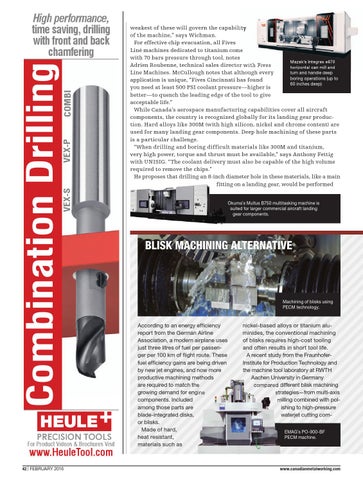COMBI VEX-P
weakest of these will govern the capability of the machine,” says Wichman. For effective chip evacuation, all Fives Liné machines dedicated to titanium come with 70 bars pressure through tool, notes Mazak’s Integrex e670 Adrien Roubenne, technical sales director with Fives horizontal can mill and Line Machines. McCullough notes that although every turn and handle deep boring operations (up to application is unique, “Fives Cincinnati has found 60 inches deep) you need at least 500 PSI coolant pressure—higher is better—to quench the leading edge of the tool to give acceptable life.” While Canada’s aerospace manufacturing capabilities cover all aircraft components, the country is recognized globally for its landing gear production. Hard alloys like 300M (with high silicon, nickel and chrome content) are used for many landing gear components. Deep hole machining of these parts is a particular challenge. “When drilling and boring difficult materials like 300M and titanium, very high power, torque and thrust must be available,” says Anthony Fettig with UNISIG. “The coolant delivery must also be capable of the high volume required to remove the chips.” He proposes that drilling an 8-inch diameter hole in these materials, like a main fitting on a landing gear, would be performed
VEX-S
Combination Drilling
High performance, time saving, drilling with front and back chamfering
Okuma’s Multus B750 multitasking machine is suited for larger commercial aircraft landing gear components.
BLISK MACHINING ALTERNATIVE
Machining of blisks using PECM technology.
For Product Videos & Brochures Visit
www.HeuleTool.com
According to an energy efficiency report from the German Airline Association, a modern airplane uses just three litres of fuel per passenger per 100 km of flight route. These fuel efficiency gains are being driven by new jet engines, and now more productive machining methods are required to match the growing demand for engine components. Included among those parts are blade-integrated disks, or blisks. Made of hard, heat resistant, materials such as
42 | FEBRUARY 2016 CdnMetal_Feb_Heule.indd 1
nickel-based alloys or titanium aluminides, the conventional machining of blisks requires high-cost tooling and often results in short tool life. A recent study from the FraunhoferInstitute for Production Technology and the machine tool laboratory at RWTH Aachen University in Germany compared different blisk machining strategies—from multi-axis milling combined with pol polishing to high-pressure waterjet cutting comEMAG’s PO-900-BF PECM machine.
www.canadianmetalworking.com 2016-01-12 10:56 AM
